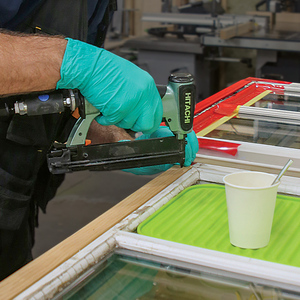I have painted plaster walls that are in need of repair. I would like to patch the cracks with finishing plaster and the manufacturer told me I need to first remove the paint for the plaster to adhere. Removing the paint ain’t easy. Any suggestions? I just started using a heat gun and scraper…then gave up.
Discussion Forum
Discussion Forum
Up Next
Video Shorts
Featured Story

Smart construction decisions and material choices can significantly improve occupant safety and survival in the event of a fire in the home.
Featured Video
How to Install Exterior Window TrimHighlights
"I have learned so much thanks to the searchable articles on the FHB website. I can confidently say that I expect to be a life-long subscriber." - M.K.
Fine Homebuilding Magazine
- Home Group
- Antique Trader
- Arts & Crafts Homes
- Bank Note Reporter
- Cabin Life
- Cuisine at Home
- Fine Gardening
- Fine Woodworking
- Green Building Advisor
- Garden Gate
- Horticulture
- Keep Craft Alive
- Log Home Living
- Military Trader/Vehicles
- Numismatic News
- Numismaster
- Old Cars Weekly
- Old House Journal
- Period Homes
- Popular Woodworking
- Script
- ShopNotes
- Sports Collectors Digest
- Threads
- Timber Home Living
- Traditional Building
- Woodsmith
- World Coin News
- Writer's Digest


















Replies
I've done a ton of plaster crack repair, and my typical choice for crack repair is not plaster but setting drywall compound. I use Durabond (20, 45, or 90, depending on the setting time I need). For extremely large damaged areas, I'll use plaster (I typically use USG Red Top Wood Fiber plaster for scratch/brown coats, and Diamond finish coat), but for cracks... just Durabond. The Durabond is really tough, which is why I don't mind using it for plaster repair.
My repair process is:
1. Gouge out the cracks with a utility knife. I'll usually gouge the cracks so that they're about an 1" wide or so.
2. Apply fiber mesh tape. I usually just stick the full 2" width in the crack, then after the first application of compound sets up, come back and trim back the tape with a utility knife so that the tape isn't sticking outside of the sides of the crack.
3. Take a plant sprayer and wet down the crack... this keeps the moisture from being sucked out of the compound too quickly, creating a weak repair.
4. Mix up mud and apply... typically about three coats are needed to build out the walls I repair (applying about an 1/8" or so each application). I typically wait about 45 minutes between applications, but this depends upon the set time of the compound.
5. Wait overnight. (I've found setting compound still shrinks somewhat, but not nearly what the bucket stuff does.) Sand, apply one final coat of compound (I'll usually use Easy Sand).
6. Finish sand, prime, paint...
Note that when the surrounding paint is latex, the application of the compound may cause the paint to peel up around the crack. Just be careful in your application not to gob too much compound on the surrounding areas (to try to avoid this from happening.) And... if it does peel, that's what the final coat of compound in step #5 takes care of. Or... you can always spray the latex with Kilz (oil-based) primer in a can before applying the compound. It'll seal off the latex.
Take a look at this link. http://www.spec-chem.com/nuwal/index.htm
I put it on in a room about 7 years ago and not a single crack has opened back up.
Just used it again on an other room. It takes some time to put up but you will never have a crack open again on a plaster wall. For the tiny cracks you don't need to do anything. This is pretty good stuff.
Edit to add, I would second the use of the setting compound, that is what I used for a few really big cracks before applying the Nuwall mat, just prime the compound before finishing.
Edited 12/6/2004 9:49 am ET by rjgogo
Is this stuff any better than fiberglass sheets and drywall compound? It seems to be on the same principle, except for the coating. I've tried FG sheets and compound to repair parts of a plastered wall/ceiling with good results. You do need a skim coat -- do you with the NuWall?
I really like the system, you roll on a saturant put up the sheet like wall paper and then roll on the saturant over the sheet. You don't need to tape every crack. No skim coat needed. If you don't like the texture they have another product you can roll on. It is much less time consuming the taping every joint and there is an added benefit of suppression of future cracks. So basically you will never have to fix cracks on a wall that has this. It pretty much fuses the wall into one piece. Again, I have one room I did about 7 years ago and there is not a single crack and it is 85 year old plaster.
I think the real benefit is the suppression of any future cracks, and I have a direct comparison between two rooms, one that was repaired with tape and mud and one that was done with this product. Cracks in the one that was done with tape and mud and 0 cracks on the one where I used this stuff. Plus it take a lot less time then waiting for coats of mud to dry.
I got a sample of that Nuwal stuff once. Looks interesting, but isn't it quite expensive compared to alternative solutions?
Seems like by the time you pay for the material, and do all of the labor, you could have patched the wall using conventional methods, or applied a vaneer layer of board.
Short term I think it would be a little less with the nu wall. If I had to repair every crack in the room I just did it would have taken much longer as there were a lot of little hairline cracks and short of skim coating the entire room I don't know how I would have done it. I think it was about $200 for the materials for the room I just did. As far as I am concerned it saved me more the $200 of my time. It is tight now. Long term much cheaper. As far as I can tell I will never have to repair the wall again, at least in the foreseeable future.
using the traditional method you go in and fix the existing cracks. You and I both know with old plaster new ones will develop in a few years. Then you have to either look at the cracks or do the whole repair all over again on the new cracks. The way this works as far as I can tell from an old installation I am done repairing these walls for good. Now which is more costly.
Also It really does not add any weight to the wall that would further pull and break the keys
I'm getting ready to repair a couple of badly cracked walls in my living room and I'm debating using NuWall or not. Maybe y'all could help with some advice?I have lots of hairline cracks that I've opened up and cleaned out with a can-opener. Most of these are 1/8 to 1/4 inches wide now. There are a couple of holes down to the lathe, probably 3x5 inches or so. There are also a couple of areas where I can feel the plaster has lost its key, probably 18x18 inches.I was thinking of fiberglass taping the cracks; filling in the holes with small cuts of drywall and then taping the joints; using plaster washers to firm up the loose areas; and then using durabond over the top of everything.If I was to go with NuWall, which of those steps could I eliminate? I assume I'd have to still fill in the holes and plaster washer up the loose stuff, right?